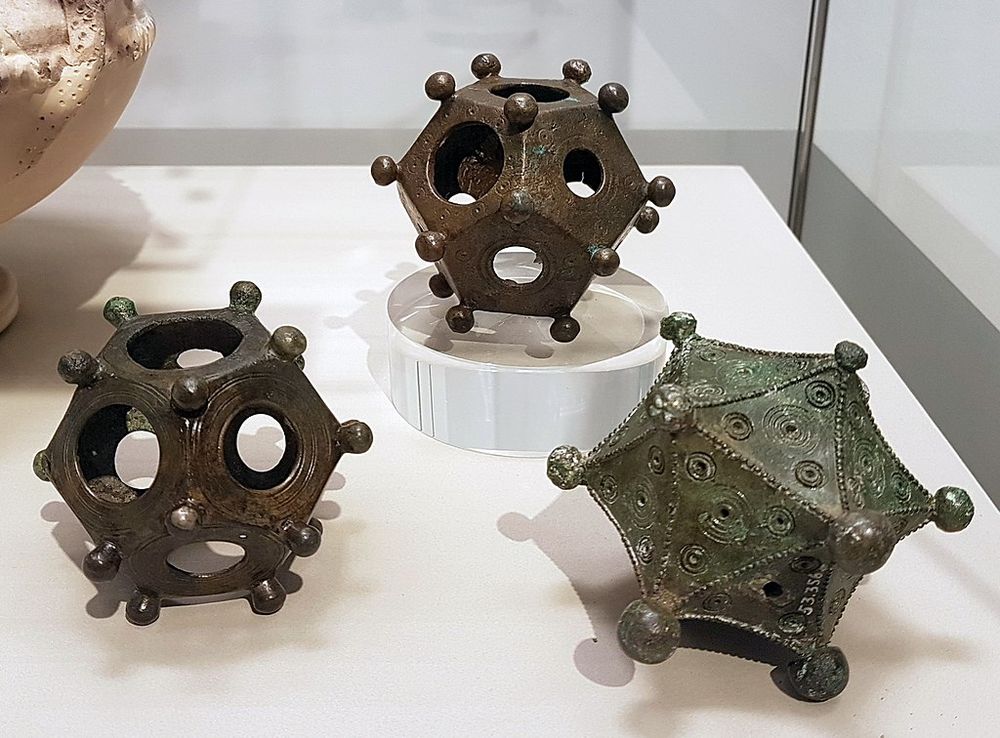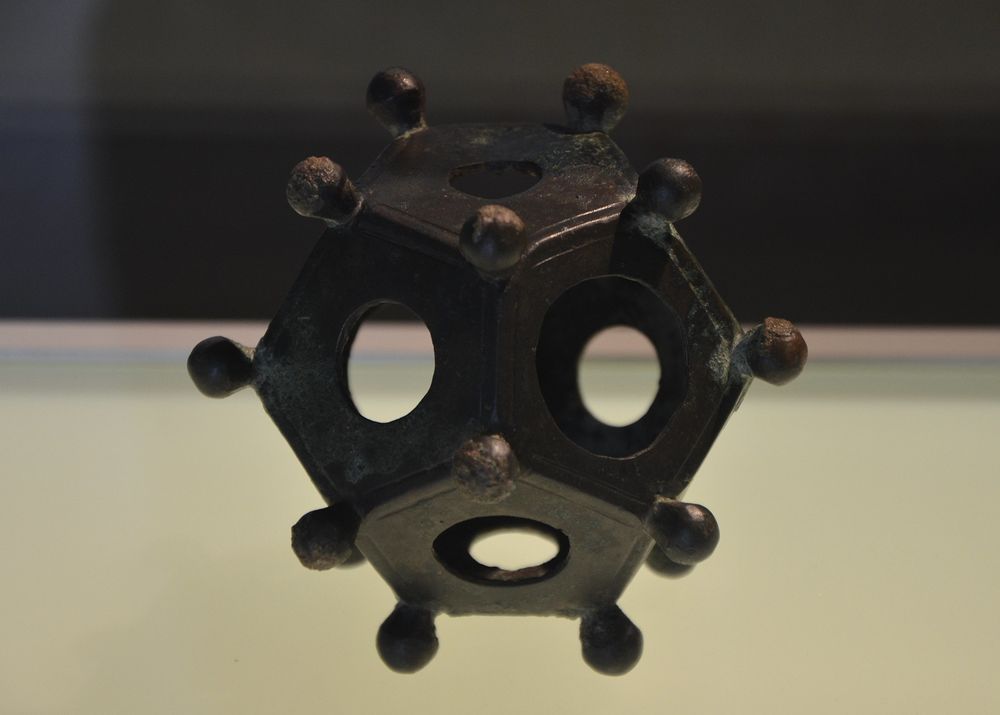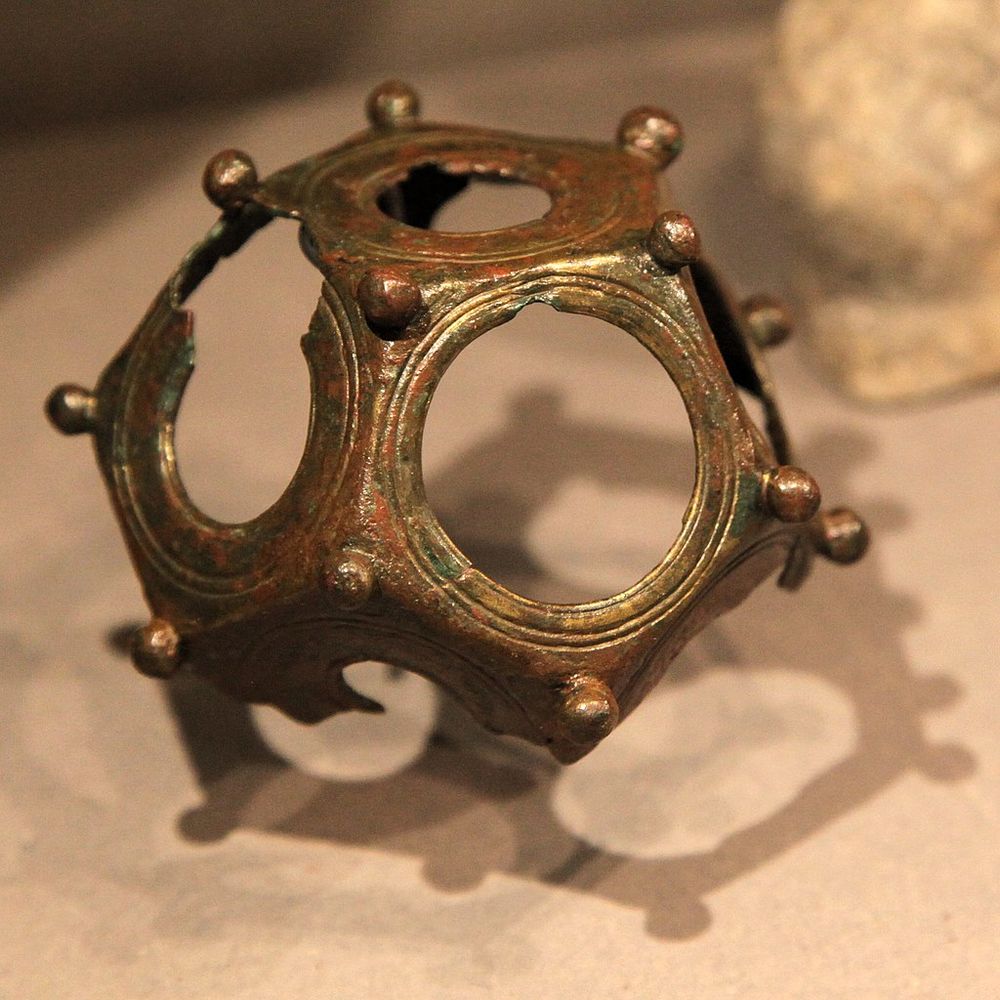It is safe to say that there are secrets to the ancient Roman civilization that even a lifetime of scrutiny will not reveal to us. Yet historians and archaeologists continue their pursuit, discovering ever so often an artifact that is at once perplexing and revealing. One such object is the Roman dodecahedron. The hollow object is a bronze enigma with a decahedral shape of twelve flat pentagonal faces. Its presence in central Europe reveals nothing of its purpose. But there are a few hypotheses that have been floated since its first discovery more than 300 years ago.

Photo: Kleon3/Wikimedia
The first dodecahedron was discovered in 1739 by a local historian in Aston, Hertfordshire along the English countryside. In his report to the Society of Antiquaries, he described the object as “a piece of mixed metal, or ancient brass, consisting of 12 equal sides.” The strange discovery had all antiquarians in a fix, but there was yet more coming their way. Each subsequently discovered object was different in size and built. Most dodecahedron vary between four and 11 centimeters in size and 35 and 580 grams in weight. Each pentagonal surface contains a hole, but the sizes of these holes almost always vary—within a single dodecahedron as well as among various ones. Each of the five vertices has a globular knob. Tinier than a tennis ball, the object seems more like an interesting dice.
By 2016, 116 pieces of dodecahedra were dug up in today’s Belgium, Croatia, France, Germany, Great-Britain, Hungary, Luxemburg, Netherlands, and Switzerland. The northernmost discovery was made at Hadrian’s Wall in Northern Britain. The southernmost was at Arles in France. A single sample made of silver was found in Geneva. Interestingly, no dodecahedron exists in eastern Roman empire as far as we know. Those found in the western region date back to the second, third and fourth century AD. The randomness of their locations as well as the lack of written context has perplexed historians further.

Photo: Carole Raddato/Flickr
In 1987 a man named Brian Campbell discovered a dodecahedron in his yard. Others were dug up in Roman military camps, temples and public baths. Some turned up in theatres and tombs, some among heaps of discarded coins. Many historians found these objects in antique stores as well, which made it difficult to trace their origin. Most were adorned with designs and patterns, but never letters or numbers that could clue us in to their use. No mention of the object has been found in Roman texts, and the excavated soil around the objects refuses to reveal the truth as well. Only two dodecahedra have been found in controlled scientific excavations. One of these sites was possibly a shop that sold precious metal wares, confirming the probability that the strange object was a precious one.
The Guessing Game

Photo: Wikimedia
Over 200 historians have proposed more than 50 possible uses of the Roman dodecahedron. A dated assumption is that the object was a weapon akin to a mace. More recently, historians are calling it a measuring device. The argument is explained by imagining a soldier looking at an object a few meters away through the dodecahedron. Supposing that the length of the object fits into the diameter of the peeping circle, what does it tell us about the distance of the object?
The dodecahedra mostly pop up in the Gallo-Roman lands where the Roman civilization overlaid the Celtic civilization. In that context, the 12 pentagonal sides can have cosmic relevance. Soothsaying and astrology would have been nearly impossible with the device though, as the knobs would make it impossible to roll them over and the walls bear no inscriptions to decipher as such. It’s possible that they were used for astronomical calculations with the sun shining through the holes at various times of the day. Dutch researcher Sjra Wagemans compared it to the icosahedron—a 20-faced convex polyhedron—which served a similar purpose. G.M.C. Wagemans has proven through various estimates that some dodecahedra could be used to determine the best time to plant winter grain in northern Europe.
Remnants of wax have been found stuck to various dodecahedra. Could this allude to their use as candlestick holders? Probably not, because the remnants could be the remains of their maker moulds. Moreover, a common object such as a candlestick holder ought to be discovered in more common regions such as Italy. But our dodecahedra have remained elusive in most regions of the ancient empire.
Other esoteric groups and lobbyists have suggested creative uses for the object from crocheting to decoration. But none of these hold much fortitude in their arguments. Could it be a toy? It does seem to fit in the popular French cup-and-ball game, the so-called Bilboquet.
The final assumption remains that the object was sacred and important to religious practice. The dodecahedron found in the Idaean Cave (Crete) was made of rock crystal, and on its twelve faces we have found Greek characters instead of holes. Some people have gone so far as to suggest that the tiny hollow object was worn as an amulet or carried around in purses.
Despite the treasure of knowledge at our disposal, modern men have found it difficult to ascertain what the use and prominence of this 2,000-year-old artifact was. Maybe, at some point, a deeper scrutiny and free-reigning imagination will reveal the secrets of this little ball that has become one of the greatest mysteries of archaeology.
References
# A Roman Dodecahedron For Measuring Distance
# Mental Floss
# The Enigma Of The Dodecahedron












Roman dodecahedra were not used for any of the listed purposes, but were used to hold different size candles, each size calculated to be the right size to keep time at night with each face for the months of a year. They used one size each month for the mean length of night and sized to mark the passing of 4 watches. Why? Because the largest number of finds (13) have been in or near to Roman forts or ccamps. Why there? To tell when to change sentries with a time of approximately 3 hours each.
ReplyDeleteExperts say thats not possible as none of the finds have the same set of size holes so could not be standard. But none need to be the same as each one would need a different set of size holes depending on the latitude north of the equator as the length of night differs with latitude.
But why have none been found near to the mediterranean but only in northern Europe areas occupied by the Romans. In areas near the mediterranean it was water clocks that were used for night clocks, so why were dodecahedra used in northeren Europe? In northeren areas what happens to water in winter? It freezes. So water clocks would not be practical and another method would be needed, thus the dodecahedra.
They are merely used as a game - a bit similar to pet food devices - a ball is placed inside which only escapes from the largest hole.
ReplyDeleteThe devise is thrown into the air and as it bounces on the ground, the winner is who threw it in such a way that the ball escaped.